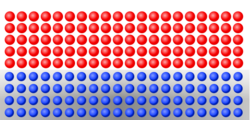Physics:Frank–van der Merwe growth
Frank–van der Merwe growth (or FM growth) is one of the three primary modes by which thin films grow epitaxially at a crystal surface or interface. It is also known as 'layer-by-layer growth'. It is considered an ideal growth model, requiring perfect lattice matching between the substrate and the layer growing on to it, and it is usually limited to homoepitaxy.[1] For FM growth to occur, the atoms that are to be deposited should be more attracted to the substrate than to each other, which is in contrast to the layer-plus-island growth model.[2] FM growth is the preferred growth model for producing smooth films.[3]
It was first described by South African physicist Jan van der Merwe and British physicist Frederick Charles Frank in a series of four papers based on van der Merwe's PhD research between 1947 and 1949.[4]
See also
- Epitaxy
- Thin films
- Molecular-beam epitaxy
References
- ↑ Cor Claeys; Eddy Simoen (29 December 2008). Extended Defects in Germanium: Fundamental and Technological Aspects. Springer Science & Business Media. pp. 158. ISBN 978-3-540-85614-6. https://books.google.com/books?id=El-4OILT_W0C&pg=PA158.
- ↑ John Venables (31 August 2000). Introduction to Surface and Thin Film Processes. Cambridge University Press. pp. 146. ISBN 978-0-521-78500-6. https://books.google.com/books?id=b0HseBYXwQIC&pg=PA146.
- ↑ Matthias Wuttig; X. Liu (17 November 2004). Ultrathin Metal Films: Magnetic and Structural Properties. Springer Science & Business Media. pp. 6. ISBN 978-3-540-58359-2. https://books.google.com/books?id=afKocJ7qTCUC&pg=PA6.
- ↑ "Journal of Materials Research: Volume 32 - Focus Issue: Jan van der Merwe: Epitaxy and the Computer Age | Cambridge Core" (in en). https://www.cambridge.org/core/journals/journal-of-materials-research/issue/focus-issue-jan-van-der-merwe-epitaxy-and-the-computer-age/35848B02A8F22B262379958D44E1325C.


